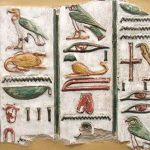 Politics
Politics  Politics
Politics  Weird Stuff
Weird Stuff Ten Bizarre Facts About The Doge Meme
 Our World
Our World 10 Ways Your Christmas Tree Is More Lit Than You Think
 Movies and TV
Movies and TV The 10 Coolest Stars to Set Sail on The Love Boat
 History
History 10 Things You Didn’t Know About the American National Anthem
 Technology
Technology Top 10 Everyday Tech Buzzwords That Hide a Darker Past
 Humans
Humans 10 Everyday Human Behaviors That Are Actually Survival Instincts
 Animals
Animals 10 Animals That Humiliated and Harmed Historical Leaders
 History
History 10 Most Influential Protests in Modern History
 Creepy
Creepy 10 More Representations of Death from Myth, Legend, and Folktale
 Politics
Politics 10 Political Scandals That Sent Crowds Into the Streets
 Weird Stuff
Weird Stuff Ten Bizarre Facts About The Doge Meme
 Our World
Our World 10 Ways Your Christmas Tree Is More Lit Than You Think
Who's Behind Listverse?

Jamie Frater
Head Editor
Jamie founded Listverse due to an insatiable desire to share fascinating, obscure, and bizarre facts. He has been a guest speaker on numerous national radio and television stations and is a five time published author.
More About Us Movies and TV
Movies and TV The 10 Coolest Stars to Set Sail on The Love Boat
 History
History 10 Things You Didn’t Know About the American National Anthem
 Technology
Technology Top 10 Everyday Tech Buzzwords That Hide a Darker Past
 Humans
Humans 10 Everyday Human Behaviors That Are Actually Survival Instincts
 Animals
Animals 10 Animals That Humiliated and Harmed Historical Leaders
 History
History 10 Most Influential Protests in Modern History
 Creepy
Creepy 10 More Representations of Death from Myth, Legend, and Folktale
10 Untranslated Texts That Hold Secrets of Forgotten Languages
In the depths of libraries and hidden archives exists a collection of literary enigmas that beckon the curious and ignite the imagination. Untranslated texts, shrouded in mystery and untouched by modern linguists, hold within their pages the untold stories of forgotten languages. These texts, like ancient cryptic codes waiting to be deciphered, whisper secrets that have remained concealed for centuries.
They are tantalizing gateways to lost civilizations, cultural traditions, and unknown realms of knowledge. Join us on a captivating journey as we delve into the world of ten untranslated texts, unlocking the potential for unraveling the secrets they hold and unearthing the captivating languages of the past. Prepare to embark on an extraordinary quest where history and language intertwine to reveal a glimpse of the mysteries that have been all but forgotten.
Related: 10 Foreign Languages That Could Go Extinct in a Few Decades
10 The Voynich Manuscript
The Voynich Manuscript, a fifteenth-century codex written in an unknown script, has long fascinated scholars and enthusiasts due to its enigmatic nature. Discovered by Wilfrid Voynich in 1912, this mysterious book features an unknown author and purpose. The manuscript’s pages are filled with intricate illustrations of otherworldly plants, unfamiliar constellations, and ethereal scenes of women swimming in fantastical tubes and green baths. Its text, known as “Voynichese,” has defied all attempts at decipherment, leaving its language and content untranslated.
The Voynich Manuscript’s origin and content remain subjects of debate and speculation. Scholars believe it may have originated in Central Europe during the fifteenth or sixteenth century. The manuscript contains botanical, figurative, and scientific illustrations, often described as combining magical and scientific content. The purpose behind these drawings and the accompanying text remains elusive.
Some theories suggest it could be an encrypted scientific or herbal manual, while others propose it to be an elaborate hoax. Despite the efforts of many researchers, including an Egyptologist who claims to have made progress in deciphering the text, the secrets of the Voynich Manuscript continue to elude us, leaving behind a captivating mystery waiting to be unraveled.[1]
9 The Phaistos Disc
The Phaistos Disc, an enigmatic artifact from Minoan Crete, continues to puzzle researchers and spark intrigue. Discovered in 1908 at the Minoan Palace of Phaistos by Luigi Pernier, the clay disc measures approximately 6.3 inches (16cm) in diameter and features 242 symbols arranged in a spiral pattern on both sides. Its origin, purpose, and meaning remain subjects of intense scholarly debate.
The unique symbols on the Phaistos Disc pose a significant challenge in deciphering their meaning. The stamped symbols display a complex and intriguing system, but their true purpose and linguistic representation remain elusive. Some scholars argue that the symbols may be connected to the ancient Minoan language, Linear A, while others suggest connections to hieroglyphs or other ancient scripts. Despite numerous attempts, the Phaistos Disc remains untranslated, and its messages, if any, remain a captivating mystery that scholars continue to investigate.[2]
8 The Rohonc Codex
The Rohonc Codex, an unidentified text discovered in Hungary, has captivated scholars for over two centuries with its enigmatic script. Believed to be from the medieval period, the Codex contains a mysterious language resembling Old Hungarian script. With 448 pages of indecipherable text and a high number of symbols surpassing any known alphabet, the origin, authorship, and purpose of the Codex remain unknown. The watermarked paper within the Codex suggests a date range of 1529–1540, but the actual writing may predate this period, adding to its mysterious nature and intrigue.
Numerous attempts have been made to translate the Rohonc Codex, but all have been unsuccessful thus far. Despite its apparent complexity, the script is not a substitution cipher but rather a unique code, posing significant challenges for codebreakers and linguists. The manuscript’s true secrets, including its possible insights into a forgotten language, remain hidden within its enigmatic text. Ongoing research and analysis continue to shed light on the characteristics and structure of the Codex, but the ultimate translation and understanding of its content remain an unsolved mystery.[3]
7 Rongorongo of Easter Island
The Rongorongo script of Easter Island, also known as Rapa Nui, is a unique hieroglyphic writing system developed by the civilization that settled on the island between AD 690 and AD 1200. This remarkable script stands as one of the few cases of independent script invention and is considered a significant achievement given the island’s isolation.
The Rongorongo script consists of pictorial signs representing various objects, but its interpretation remains a challenge, with ongoing scholarly debates regarding the exact number of signs and the deciphering of textual fragments. Only twenty-four authentic inscribed objects, such as wooden tablets, remain today, and the decline of the script began with Peruvian slave raids in 1862.
The purpose and meaning of the Rongorongo script continue to elude researchers. Some theories suggest that the tablets were used as mnemonic devices by priest-chanters to recite sacred chants, incantations, and genealogies accurately. The tablets aided in remembering the order and content of the chants, demonstrating a more evolved system than mere pictography.
While the exact origins and age of the writing system are subjects of academic debate, oral traditions indicate that rongorongo tablets were present on Easter Island since the earliest settlers arrived between the 9th and 12th centuries. The potential insights the Rongorongo script could provide into the isolated Rapa Nui civilization, its language, history, and culture continue to intrigue scholars and fuel ongoing international discussions.[4]
6 Linear A
Linear A is an ancient, undeciphered writing system used by the Minoan civilization on the island of Crete during the Bronze Age. The script consists of symbols that have yet to be fully understood or translated. Despite its mysterious nature, Linear A shares some similarities with the deciphered Linear B script, which was also used by the Minoans and later adopted by the Mycenaeans. Linear B provided valuable insights into the administrative and economic systems of the ancient Aegean civilizations. However, the secrets of Linear A remain hidden, leaving scholars intrigued and eager to uncover its meaning and significance.
The untranslated texts of Linear A hold the potential to reveal crucial secrets about the Minoan civilization. It could provide insights into their language, religious practices, societal structure, trade networks, and cultural traditions. By deciphering Linear A, we may gain a deeper understanding of the Minoan people, their beliefs, and their interactions with other ancient societies.
The Minoans were known for their advanced seafaring culture, distinctive art styles, and prosperous trade routes, and unlocking the secrets of Linear A may shed light on their intellectual achievements and contributions to ancient civilization. However, until the code of Linear A is cracked, its secrets will continue to elude us, adding to the enigma surrounding the Minoan civilization and leaving us with a tantalizing mystery of the past.[5]
5 The Indus Script
The Indus Script is a collection of symbols found on artifacts from the Indus Valley Civilization, which thrived from approximately 2500 to 1700 BC in the Indian subcontinent. The symbols, consisting of around 400 known signs, are often pictorial in nature and have been found on a variety of objects, including seals, pottery, and tablets. Some symbols depict animals, plants, and everyday objects, while others are more abstract in form.
Despite extensive research, the Indus Script remains undeciphered, and there is an ongoing debate among scholars about whether it constitutes a language. The lack of a bilingual text or a known key to unlocking the script’s meaning has posed significant challenges in deciphering it.
The secrets held within the Indus Script have the potential to provide valuable insights into the Indus Valley Civilization. Deciphering the script could reveal information about their language, religious beliefs, political structures, and social organization. It may shed light on their economic systems, trade networks, and cultural practices. The symbols could hold clues about the development of writing systems and communication in the ancient world.
Furthermore, understanding the Indus Script may help unravel the mystery of the decline of the Indus Valley Civilization and the factors that led to its eventual collapse. Despite the ongoing challenges, continued research and new discoveries offer hope for eventually deciphering the Indus Script and unlocking the secrets of this ancient civilization.[6]
4 The Etruscan Language
The Etruscan language, spoken by the ancient Etruscan civilization in Italy, remains only partially understood. The Etruscans, who preceded the Romans in central and northern Italy, left behind numerous inscriptions, but the language itself has proven difficult to decipher due to its lack of clear connections to neighboring languages.
However, recent discoveries have offered glimpses into this mysterious language. One significant finding is a monumental sandstone marker unearthed at the Poggio Colla site, which bears inscriptions of legible letters and punctuation marks. This discovery provides a new opportunity to gain insights into the Etruscan language, potentially revealing words and names of their gods that go beyond the usual funerary texts.
The untranslated texts of the Etruscan civilization hold secrets that could shed light on various aspects of their society and culture. These texts could potentially provide insights into their government, daily life, religious beliefs, and cultural practices. The Etruscans significantly influenced Roman development, impacting social practices and religion. Despite once ruling Rome, their cultural identity was lost when Rome conquered and assimilated Etruria.
With nearly 13,000 Etruscan inscriptions discovered so far, these texts reveal a non-Indo-European language that may have ancient origins, potentially dating back to the Neolithic period. The Etruscan alphabet, influenced by Greek or Phoenician systems, consisted of 26 letters. Deciphering the Etruscan language would unlock a wealth of knowledge about this intriguing civilization and its contributions to the Classical world.[7]
3 The Proto-Elamite Script
The Proto-Elamite script, the oldest undeciphered writing system from ancient Iran, presents an intriguing puzzle for archaeologists and linguists. Discovered in ancient ruins in Susa, Iran, this script belongs to the Elamite civilization of the Bronze Age. While some progress has been made in deciphering Linear Elamite, challenges remain in understanding its full meaning and syntax.
French archaeologist Francois Desset and his team have made notable strides in decipherment by examining inscriptions on silver cups, comparing them with Mesopotamian cuneiform script, and identifying recurring character sequences. Through this comparative analysis, they successfully deciphered 72 characters, shedding light on the ancient writing system.
Decoding the Proto-Elamite script has the potential to provide valuable insights into early urban civilization in ancient Iran. The deciphered portions of the script reveal aspects of the language used by the Elamite kingdom, which later became part of the Persian Empire. The script’s understanding could shed light on the language, culture, and history of this powerful ancient civilization.
However, deciphering the remaining parts of the script remains a complex task due to the lack of direct translation between Linear Elamite and other known scripts like cuneiform. Nonetheless, recent progress in deciphering the script through comparative analysis offers hope for unraveling the secrets of this ancient writing system and gaining a deeper understanding of the people who used it.[8]
2 The Zapotec Script
The Zapotec script, an ancient Mesoamerican writing system, presents a fascinating puzzle that has been only partially deciphered. The script dates back to around 600 BC and was used to encode an ancient version of the Zapotecan languages spoken in the central valleys of Oaxaca, Mexico. While the script has not been fully deciphered, significant progress has been made in understanding its role in shaping group identities, facilitating political centralization, and urban development. Despite this progress, untranslated texts in the Zapotec script remain, holding secrets that could shed light on the Zapotec civilization and their cultural practices.
The untranslated texts in the Zapotec script may hold valuable insights into various aspects of the Zapotec civilization. They could potentially reveal details about religious beliefs, social structures, and political systems. The script’s evolution over time, from a more phonetic encoding to a focus on logophonic, semantic, and multilingual aspects, suggests a complex system of communication and knowledge exchange.
Unraveling the secrets of the untranslated texts may provide a deeper understanding of the Zapotecan languages, their linguistic features, and the cultural diversity within the Zapotec civilization. The ongoing efforts to decipher the Zapotec script offer a tantalizing glimpse into the rich history of the Zapotec civilization and the complexities of their written language.[9]
1 The Olmec Script
The Olmec civilization, an influential pre-Columbian culture in Mesoamerica, left behind artifacts adorned with symbols that offer glimpses into their ancient language. The Olmecs, known as the “rubber people,” were skilled in harvesting and processing rubber from local trees. Their civilization thrived from approximately 1200 to 400 BC and served as a foundational influence on subsequent cultures like the Maya and the Aztecs.
The symbols found on Olmec artifacts include intricate designs, glyphs, and inscriptions that are believed to represent their language and convey important messages. However, the Olmec script remains largely untranslated, posing a mystery to researchers and linguists. Debates surround whether the Olmec symbols constitute a fully developed writing system. Some experts argue that the Olmec script might be more of a proto-writing system or a mix of pictorial symbols and logograms.
The ongoing research aims to decipher the meanings and grammar behind these symbols and determine whether they represent a true language with phonetic elements. Unlocking the Olmec script would provide invaluable insights into the civilization’s cultural, religious, and political aspects. It could reveal details about their mythologies, rituals, historical events, and societal structures. By understanding the Olmec language, we could better understand their worldview, interactions with neighboring civilizations, and their contributions to developing Mesoamerican cultures.[10]








